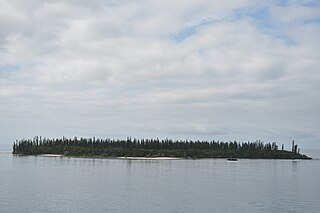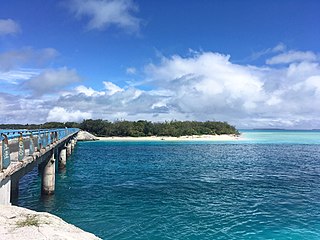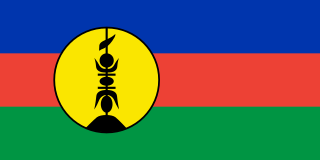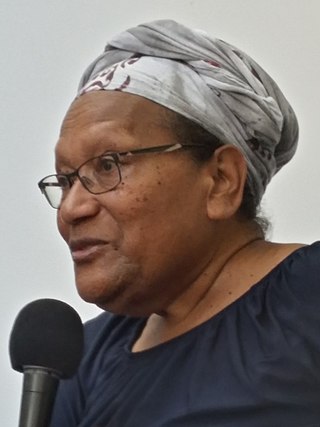
Demographic features of the population of New Caledonia include population density, ethnicity, education level, health of the populace, economic status, religious affiliations and other aspects of the population.

Demographic features of the population of New Caledonia include population density, ethnicity, education level, health of the populace, economic status, religious affiliations and other aspects of the population.
|
| |||||||||||||||||||||||||||||||||||||||||||||
| ISEE [1] | ||||||||||||||||||||||||||||||||||||||||||||||
| Age Group | Male | Female | Total | % |
|---|---|---|---|---|
| Total | 140 000 | 138 495 | 278 495 | 100 |
| 0–4 | 10 481 | 10 106 | 20 587 | 7.39 |
| 5–9 | 11 009 | 10 286 | 21 295 | 7.65 |
| 10–14 | 10 922 | 10 583 | 21 505 | 7.72 |
| 15–19 | 11 621 | 11 342 | 22 963 | 8.25 |
| 20–24 | 10 329 | 9 608 | 19 937 | 7.16 |
| 25–29 | 10 338 | 10 400 | 20 738 | 7.45 |
| 30–34 | 10 760 | 10 727 | 21 487 | 7.72 |
| 35–39 | 10 255 | 10 462 | 20 717 | 7.44 |
| 40–44 | 10 853 | 10 702 | 21 555 | 7.74 |
| 45–49 | 9 795 | 9 949 | 19 744 | 7.09 |
| 50–54 | 8 939 | 8 780 | 17 719 | 6.36 |
| 55–59 | 7 010 | 6 945 | 13 955 | 5.01 |
| 60–64 | 5 722 | 5 508 | 11 230 | 4.03 |
| 65-69 | 4 516 | 4 361 | 8 877 | 3.19 |
| 70-74 | 3 339 | 3 311 | 6 650 | 2.39 |
| 75-79 | 2 157 | 2 485 | 4 642 | 1.67 |
| 80-84 | 1 198 | 1 595 | 2 793 | 1.00 |
| 85-89 | 607 | 931 | 1 538 | 0.55 |
| 90-94 | 119 | 317 | 436 | 0.16 |
| 95+ | 30 | 97 | 127 | 0.05 |
| Age group | Male | Female | Total | Percent |
| 0–14 | 32 412 | 30 975 | 63 387 | 22.76 |
| 15–64 | 95 622 | 94 423 | 190 045 | 68.24 |
| 65+ | 11 966 | 13 097 | 25 063 | 9.00 |
Births and deaths [3]
| Year | Population | Live births | Deaths | Natural increase | Crude birth rate | Crude death rate | Rate of natural increase | TFR |
|---|---|---|---|---|---|---|---|---|
| 1981 | 140,050 | 3,668 | 914 | 2,754 | 27.7 | 6.4 | 21.3 | 3.64 |
| 1982 | 145,700 | 3,830 | 914 | 2,916 | 26.3 | 6.3 | 20.0 | 3.41 |
| 1983 | 148,700 | 3,832 | 848 | 2,984 | 25.8 | 5.7 | 20.1 | 3.33 |
| 1984 | 151,650 | 3,763 | 905 | 2,858 | 24.8 | 6.0 | 18.8 | 3.17 |
| 1985 | 154,450 | 3,619 | 891 | 2,728 | 23.4 | 5.8 | 17.7 | 3.00 |
| 1986 | 157,350 | 3,921 | 904 | 3,017 | 24.9 | 5.7 | 19.2 | 3.17 |
| 1987 | 160,500 | 4,122 | 913 | 3,209 | 25.7 | 5.7 | 20.0 | 3.25 |
| 1988 | 163,650 | 4,035 | 962 | 3,073 | 24.7 | 5.9 | 18.8 | 3.10 |
| 1989 | 166,898 | 3,944 | 990 | 2,954 | 23.6 | 5.9 | 17.7 | 2.97 |
| 1990 | 170,899 | 4,378 | 928 | 3,450 | 25.6 | 5.4 | 20.2 | 3.19 |
| 1991 | 175,362 | 4,501 | 978 | 3,523 | 25.7 | 5.6 | 20.1 | 3.15 |
| 1992 | 179,799 | 4,405 | 931 | 3,474 | 24.5 | 5.2 | 19.3 | 2.99 |
| 1993 | 184,496 | 4,337 | 954 | 3,383 | 23.5 | 5.2 | 18.3 | 2.86 |
| 1994 | 189,482 | 4,267 | 1,060 | 3,207 | 22.5 | 5.6 | 16.9 | 2.70 |
| 1995 | 193,816 | 4,242 | 1,020 | 3,222 | 21.9 | 5.3 | 16.6 | 2.59 |
| 1996 | 197,564 | 4,401 | 1,020 | 3,381 | 22.3 | 5.2 | 17.1 | 2.65 |
| 1997 | 201,418 | 4,490 | 1,016 | 3,474 | 22.3 | 5.0 | 17.2 | 2.67 |
| 1998 | 205,279 | 4,352 | 982 | 3,370 | 21.2 | 4.8 | 16.4 | 2.55 |
| 1999 | 209,214 | 4,316 | 1,095 | 3,221 | 20.6 | 5.2 | 15.4 | 2.48 |
| 2000 | 213,230 | 4,566 | 1,077 | 3,489 | 21.4 | 5.1 | 16.4 | 2.59 |
| 2001 | 217,324 | 4,326 | 1,131 | 3,195 | 19.9 | 5.2 | 14.7 | 2.43 |
| 2002 | 221,490 | 4,194 | 1,121 | 3,073 | 18.9 | 5.1 | 13.9 | 2.33 |
| 2003 | 225,296 | 4,102 | 1,121 | 2,981 | 18.2 | 5.0 | 13.2 | 2.27 |
| 2004 | 228,750 | 3,978 | 1,116 | 2,862 | 17.4 | 4.9 | 12.5 | |
| 2005 | 232,250 | 4,051 | 1,142 | 2,909 | 17.4 | 4.9 | 12.5 | |
| 2006 | 235,750 | 4,224 | 1,113 | 3,111 | 17.9 | 4.7 | 13.2 | |
| 2007 | 239,250 | 4,093 | 1,207 | 2,886 | 17.1 | 5.0 | 12.1 | |
| 2008 | 242,750 | 4,015 | 1,169 | 2,846 | 16.5 | 4.8 | 11.7 | |
| 2009 | 245,950 | 4,103 | 1,261 | 2,842 | 16.7 | 5.1 | 11.6 | |
| 2010 | 249,750 | 4,178 | 1,191 | 2,987 | 16.7 | 4.8 | 12.0 | 2.20 |
| 2011 | 254,350 | 4,119 | 1,320 | 2,799 | 16.2 | 5.2 | 11.0 | 2.15 |
| 2012 | 259,000 | 4,389 | 1,322 | 3,067 | 16.9 | 5.1 | 11.8 | 2.28 |
| 2013 | 263,650 | 4,373 | 1,374 | 2,999 | 16.6 | 5.2 | 11.4 | 2.19 |
| 2014 | 268,050 | 4,370 | 1,406 | 2,964 | 16.3 | 5.2 | 11.1 | 2.17 |
| 2015 | 269,460 | 4,191 | 1,465 | 2,726 | 15.6 | 5.4 | 10.2 | 2.08 |
| 2016 | 270,220 | 4,271 | 1,569 | 2,702 | 15.8 | 5.8 | 10.0 | 2.13 |
| 2017 | 270,810 | 4,067 | 1,531 | 2,536 | 15.0 | 5.7 | 9.3 | 2.04 |
| 2018 | 271,240 | 4,076 | 1,556 | 2,520 | 15.0 | 5.7 | 9.3 | 2.06 |
| 2019 | 271,228 | 4,110 | 1,627 | 2,483 | 15.2 | 6.0 | 9.2 | 2.10 |
| 2020 | 271,080 | 3,991 | 1,540 | 2,451 | 14.6 | 5.7 | 8.9 | 2.05 |
| 2021 | 270,390 | 3,931 | 1,985 | 1,946 | 14.3 | 7.3 | 7.0 | 2.05 |
| 2022 | 269,215 | 3,805 | 1,900 | 1,905 | 14.1 | 7.1 | 7.0 | 2.02 |
| 2023 | 3,358 | 1,440 | 1,918 | 12.5 | 5.4 | 7.1 | ||
Ethnic Melanesians known as Kanak constituted 41.2% of the population in 2019, followed by Europeans (Caldoche and Zoreille) with 24.1%. The Europeans are the largest ethnic group in the South Province, where they make up a plurality, while Kanak are the majority in the two other provinces. The remainder of the population are Wallis and Futunan (8.3%), Tahitian (2.0%), Indonesians (1.4%), Ni-Vanuatu (0.9%), Vietnamese, other Asian (0.4%), Mixed (11.3%), and belong to other ethnic groups (9.5%). An estimate of 15,000 Caledonians were of Algerian descent. [4]
| Ethnic group | census 1963 | census 1969 | census 1976 | census 1983 | census 1989 | census 1996 | census 2009 | census 2014 | census 2019 | |||||||||
|---|---|---|---|---|---|---|---|---|---|---|---|---|---|---|---|---|---|---|
| Number | % | Number | % | Number | % | Number | % | Number | % | Number | % | Number | % | Number | % | Number | % | |
| Kanak | 41,190 | 47.6 | 46,200 | 45.9 | 55,598 | 41.7 | 61,870 | 42.6 | 73,598 | 44.8 | 86,788 | 44.1 | 99,078 | 40.3 | 104,958 | 39.1 | 111,856 | 41.2 |
| Europeans | 33,355 | 38.6 | 41,268 | 41.0 | 50,757 | 38.1 | 53,974 | 37.1 | 55,085 | 33.6 | 67,151 | 34.1 | 71,721 | 29.2 | 73,199 | 27.2 | 65,488 | 24.1 |
| Wallisians and Futunians | 11,974 | 13.8 | 13,111 | 13.0 | 9,571 | 7.2 | 12,174 | 8.4 | 14,186 | 8.6 | 17,763 | 9.0 | 21,262 | 8.7 | 21,926 | 8.2 | 22,520 | 8.3 |
| Tahitians | 6,391 | 4.8 | 5,570 | 3.8 | 4,750 | 2.9 | 5,871 | 2.6 | 4,985 | 2.0 | 5,608 | 2.1 | 5,366 | 2.0 | ||||
| Ni-Vanuatu | 1,050 | 0.8 | 1,212 | 0.8 | 1,683 | 1.0 | 2,244 | 1.1 | 2,327 | 0.9 | 2,568 | 1.0 | 2,313 | 0.9 | ||||
| Indonesians | 5,111 | 3.8 | 5,319 | 3.7 | 5,191 | 3.2 | 5,003 | 2.5 | 3,767 | 1.6 | 3,859 | 1.4 | 3,786 | 1.4 | ||||
| Vietnamese | 1,943 | 1.5 | 2,381 | 1.6 | 2,461 | 1.5 | 2,822 | 1.4 | 2,357 | 1.0 | 2,506 | 0.9 | 2,230 | 0.8 | ||||
| Others | 2,812 | 2.1 | 2,868 | 2.0 | 7,219 | 4.4 | 9,894 | 5.0 | 39,865 | 16.2 | 54,143 | 20.1 | 57,848 | 21.3 | ||||
| Total | 86,519 | 100,579 | 133,233 | 145,368 | 164,173 | 196,836 | 245,580 | 268,767 | 271,407 | |||||||||

New Caledonia is a group of islands in the southwest Pacific Ocean, 220 km (140 mi) southwest of Vanuatu and 1,210 km (750 mi) east of Australia. Located 16,100 km (10,000 mi) from Metropolitan France, it forms a sui generis collectivity of the French Republic, a legal status unique in overseas France and enshrined in a dedicated chapter of the French Constitution.

Demographic features of the population of Solomon Islands include population density, ethnicity, education level, health of the populace, economic status, religious affiliations and other aspects.

Pacific Islanders, Pasifika, Pasefika, Pacificans, or rarely Pacificers are the peoples of the Pacific Islands. As an ethnic/racial term, it is used to describe the original peoples—inhabitants and diasporas—of any of the three major subregions of Oceania or any other island located in the Pacific Ocean.

Nouméa is the capital and largest city of the French special collectivity of New Caledonia and is also the largest Francophone city in Oceania. It is situated on a peninsula in the south of New Caledonia's main island, Grande Terre, and is home to the majority of the island's European, Polynesian, Indonesian, and Vietnamese populations, as well as many Melanesians, Ni-Vanuatu and Kanaks who work in one of the South Pacific's most industrialised cities. The city lies on a protected deepwater harbour that serves as the chief port for New Caledonia.

Melanesians are the predominant and indigenous inhabitants of Melanesia, in an area stretching from New Guinea to the Fiji Islands. Most speak one of the many languages of the Austronesian language family or one of the many unrelated families of Papuan languages. There are several creoles of the region, such as Tok Pisin, Hiri Motu, Solomon Islands Pijin, Bislama, and Papuan Malay.

The Isle of Pines is an island in the Pacific Ocean, in the archipelago of New Caledonia, an overseas collectivity of France. The island is part of the commune (municipality) of L'Île-des-Pins, in the South Province of New Caledonia. The Isle of Pines is nicknamed l'île la plus proche du paradis.

Ouvéa or Uvea is a commune in the Loyalty Islands Province of New Caledonia, an overseas territory of France in the Pacific Ocean. The settlement of Fayaoué, on Ouvéa Island, is the administrative centre of the commune.
Future Together was a center-right political party in New Caledonia supporting the maintenance of political and administrative ties with France.

European exploration and settlement of Oceania began in the 16th century, starting with the Spanish (Castilian) landings and shipwrecks in the Mariana Islands, east of the Philippines. This was followed by the Portuguese landing and settling temporarily in some of the Caroline Islands and Papua New Guinea. Several Spanish landings in the Caroline Islands and New Guinea came after. Subsequent rivalry between European colonial powers, trade opportunities and Christian missions drove further European exploration and eventual settlement. After the 17th century Dutch landings in New Zealand and Australia, with no settlement in these lands, the British became the dominant colonial power in the region, establishing settler colonies in what would become Australia and New Zealand, both of which now have majority European-descended populations. States including New Caledonia (Caldoche), Hawaii, French Polynesia, and Norfolk Island also have considerable European populations. Europeans remain a primary ethnic group in much of Oceania, both numerically and economically.

Caldoche is the name given to inhabitants of the French overseas collectivity of New Caledonia of European ethnic origin who have settled in New Caledonia since the 19th century. The formal name to refer to this particular population is Calédoniens, short for the very formal Néo-Calédoniens, but this self-appellation technically includes all inhabitants of the New Caledonian archipelago, not just the Caldoche.

Loyalty Islands Province is one of the three top-level administrative subdivisions of New Caledonia. It encompasses the Loyalty Islands archipelago in the Pacific Ocean, located northeast of the New Caledonian mainland of Grande Terre.

In New Caledonia, a sui generis collectivity of France, French is the official and predominant language. The collectivity is also home to about thirty New Caledonian languages, which form a branch of the Southern Oceanic languages. They are spoken mainly by the indigenous Kanaks of the islands.
Jawe is one of the Kanak languages spoken in the northern province of the largest island of New Caledonia named Grande Terre. Jawe speakers are located along the northeast coast of the island, north of Hienghène and south of Pouébo; primarily in the Cascada de Tao region, Tchambouenne, and in the upper valleys of both sides of the centrally dividing mountain range.

The Kanaks are the indigenous Melanesian inhabitants of New Caledonia, an overseas collectivity of France in the southwest Pacific. Kanak peoples traditionally speak diverse Austronesian languages that belong to the New Caledonian branch of Oceanic. According to the 2019 census, the Kanaks make up 41.2% of New Caledonia's total population – corresponding to around 112,000 people. The other populations are the Caldoche, who are European born in New Caledonia; the Zoreille, who were born in metropolitan France and live in New Caledonia, in addition to about 10% that are non-Kanak Polynesians and 10% that are mixed race.

An independence referendum was held in New Caledonia on 4 November 2018. Voters were given the choice of remaining part of France or becoming an independent country.

Déwé Gorodey was a New Caledonian teacher, writer, feminist and politician. She was active in agitating for independence from France in the 1970s. She published poetry, short stories and novels. From 1999, she was a member of the New Caledonian government, representing the pro-independence Kanak and Socialist National Liberation Front. From April 2001 to June 2009, she served almost continuously as Vice President of the Government of New Caledonia.

An independence referendum was held in New Caledonia on 4 October 2020. The poll was the second to be held under the terms of the Nouméa Accord, following a similar referendum in 2018.
Javanese New Caledonians are an ethnic group of full or partial Javanese descent in New Caledonia. They have been present since between 1896 and 1949. They were sent as plantation workers administered by the Dutch colonial government in New Caledonia.

The Javanese diaspora is the demographic group of descendants of ethnic Javanese who emigrated from the Indonesian island of Java to other parts of the world. The Javanese diaspora includes a significant population in Suriname, with over 13% of the country's population being of Javanese ancestry. Other major enclaves are found in French Guiana, Malaysia, the Netherlands, New Caledonia, Singapore, South Africa, and Sri Lanka.
An independence referendum was held in New Caledonia, a French territory in the South Pacific, on 12 December 2021. The vote was the third and final one to be held under the terms of the Nouméa Accord, following votes in 2018 and 2020.